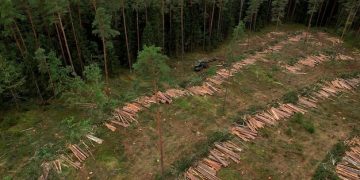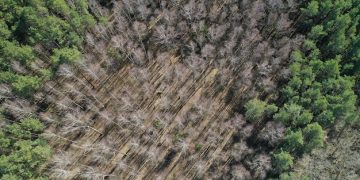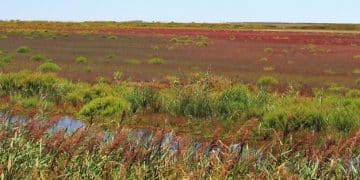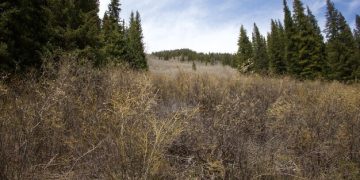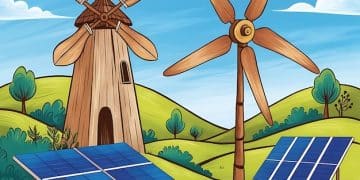Deforestation and Biodiversity Loss: Impacts on US Ecosystems
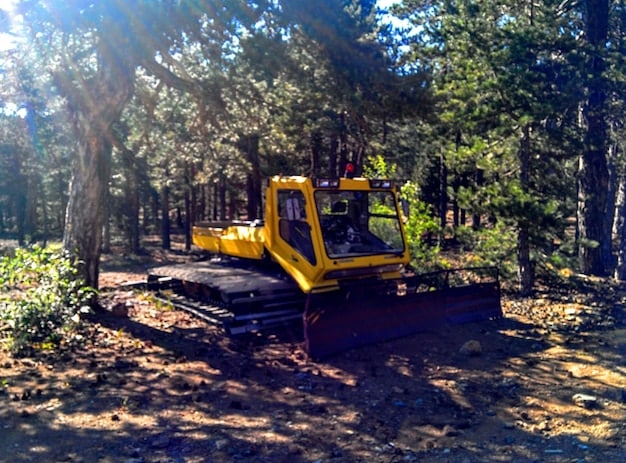
Deforestation and the loss of biodiversity in the United States pose significant threats to ecosystems, impacting vital processes such as pollination, water purification, and climate regulation while also endangering numerous plant and animal species.
The United States faces a growing challenge with deforestation and the loss of biodiversity. Understanding the stakes is crucial for preserving our natural heritage and ensuring the health of our ecosystems. Let’s explore the impacts and what we can do to protect our environment.
What is Deforestation and Why Does it Happen in the US?
Deforestation, simply put, is the clearing of forests for other land uses. In the United States, this can occur for a variety of reasons, ranging from agriculture and urban development to resource extraction and natural disasters.
Understanding the drivers behind deforestation is the first step in addressing its harmful effects on our biodiversity and overall ecosystem health.
Agricultural Expansion
One of the primary drivers of deforestation in the US is the expansion of agricultural land. As the demand for food and biofuel crops increases, forests are often cleared to make way for farms and pastures.
Urban Development
Rapid urbanization also contributes significantly to deforestation. As cities and suburbs grow, forests are converted into residential areas, commercial centers, and infrastructure projects.
- Logging Practices: Unsustainable logging, even when legally permitted, can severely degrade forest ecosystems and lead to long-term biodiversity loss.
- Natural Disasters: Events like wildfires, hurricanes, and insect infestations can destroy vast areas of forest, effectively causing deforestation.
- Mining Operations: Extracting minerals and resources often involves clearing forests to access underlying deposits, leaving behind scarred landscapes.
Deforestation in the US doesn’t just mean fewer trees. It triggers a cascade of ecological impacts, most notably the loss of biodiversity. This means the variety of plant and animal life – essential for healthy ecosystems – is severely diminished.

The Link Between Deforestation and Biodiversity Loss
Deforestation and biodiversity loss are intricately linked. When forests are cleared, habitats are destroyed, and countless species of plants and animals are displaced or face extinction. This disruption of ecosystems has far-reaching consequences. The destruction of forests directly leads to the reduction of various species populations and overall biodiversity.
The connection between deforestation and biodiversity loss is critical to understand, as it shows how one action can spiral into multiple environmental problems.
Habitat Destruction
Forests are home to a vast array of species, providing them with food, shelter, and breeding grounds. When these forests are cleared, these habitats are destroyed, leaving many species without a place to live.
Disruption of Food Chains
Deforestation can disrupt intricate food chains, leading to population declines and even extinctions. The removal of a single keystone species can have cascading effects throughout the entire ecosystem.
- Fragmentation of Habitats: Even partial deforestation can fragment habitats, isolating populations and reducing genetic diversity, increasing their vulnerability to diseases and environmental changes.
- Increased Invasive Species: Disturbed ecosystems are more susceptible to invasive species, which can outcompete native species and further reduce biodiversity.
- Loss of Genetic Diversity: Deforestation reduces the overall size of many populations, leading to a loss of genetic diversity, making species less resilient to environmental stressors.
Deforestation reduces the variety of species and disrupts the roles these species play in the complex web of life. This can affect everything from pollination and seed dispersal to nutrient cycling and disease regulation.
Impacts on US Ecosystems: From Forests to Waterways
The impacts of deforestation ripple across US ecosystems, affecting not only forests but also waterways, soil health, and air quality. The consequences are wide-ranging and interconnected, underscoring the critical role forests play in maintaining ecological balance.
Understanding the consequences of deforestation helps us appreciate the importance of forest conservation for the health of our environment.
Forest Ecosystems
The most direct impact is on forest ecosystems themselves. Deforestation reduces forest cover, alters species composition, and disrupts natural processes like nutrient cycling and carbon sequestration.
Waterways
Deforestation can lead to soil erosion and sedimentation in waterways, degrading water quality and harming aquatic life. It can also increase the risk of flooding as forests no longer act as natural sponges.
- Soil Degradation: Loss of tree cover can lead to soil erosion, nutrient depletion, and compaction, reducing the ability of the land to support plant growth.
- Air Quality: Deforestation reduces the ability of forests to absorb air pollutants and release oxygen, contributing to air pollution and climate change.
- Climate Regulation: Forests play a crucial role in regulating regional and global climate patterns. Deforestation interferes with these processes, contributing to climate change and extreme weather events.
The effects of deforestation extend far beyond our forests. Its impacts on US ecosystems create a domino effect, affecting various aspects of our environment and quality of life.
Threatened Species and Habitats in the US
Deforestation is a major threat to numerous plant and animal species in the United States, many of which are already listed as threatened or endangered. The loss of habitat and disruption of ecosystems pushes these species closer to extinction.
Protecting these threatened species and habitats is part of the broader effort to protect our biodiversity.
Endangered Species
Deforestation directly contributes to the decline of many endangered species by destroying their habitats and disrupting food chains. Species like the spotted owl and the red-cockaded woodpecker are particularly vulnerable.
Habitat Loss
Critical habitats, such as old-growth forests and riparian areas, are especially vulnerable to deforestation. The loss of these habitats has cascading effects on the species that depend on them.
- Fragmentation of Ecosystems: Deforestation often leads to fragmentation of ecosystems, isolating populations and reducing genetic diversity. This can further endanger already vulnerable species.
- Climate Change Impacts: Deforestation exacerbates the impacts of climate change, such as altered weather patterns and increased frequency of extreme events, which can further threaten species and habitats.
- Importance of Conservation Efforts: Active conservation efforts, including habitat restoration and protection of endangered species, are crucial to mitigating the impacts of deforestation.
Deforestation poses a huge threat to many of our species and habitats, and the effects can be irreversible. Protecting the species and habitats that rely on our forests is important if we want to maintain our country’s ecosystems.

Economic Consequences of Deforestation
While the ecological impacts of deforestation are well-documented, the economic consequences can often be overlooked. Deforestation can have significant impacts on various sectors, from forestry and tourism to agriculture and water management. The impact on these industries is massive.
Understanding the economic consequences of deforestation can strengthen the case for sustainable forest management and conservation.
Forestry Industry
Unsustainable logging practices and deforestation can ultimately harm the forestry industry by depleting timber resources and degrading forest ecosystems. Sustainable forest management is crucial for long-term economic viability.
Tourism and Recreation
Deforestation can negatively impact tourism and recreation by degrading scenic landscapes and reducing opportunities for outdoor activities like hiking, fishing, and wildlife viewing.
- Agriculture: Deforestation can lead to soil erosion and water scarcity, harming agricultural productivity and increasing the risk of crop failure.
- Water Management: Loss of forest cover can disrupt water cycles and increase the risk of flooding and droughts, impacting water supplies for agriculture, industry, and domestic use.
- Long-Term Economic Costs: The long-term economic costs of deforestation, including ecosystem services losses and disaster recovery, often outweigh the short-term economic gains.
Deforestation has far-reaching economic consequences. That is why protecting forests can have far-reaching and significant benefits for individuals and businesses.
Sustainable Solutions and Conservation Efforts
Addressing deforestation requires a combination of sustainable solutions and proactive conservation efforts. These strategies promote responsible land use, protect forests, and mitigate the harmful impacts of deforestation on biodiversity and ecosystems.
Adopting sustainable solutions and conservation efforts is essential for ensuring the long-term health and resilience of our forests and ecosystems.
Sustainable Forest Management
Implementing sustainable forest management practices ensures that forests are harvested responsibly, with consideration for biodiversity, water quality, and long-term forest health.
Reforestation and Afforestation
Reforestation (replanting trees in deforested areas) and afforestation (planting trees in areas that were not previously forested) can help restore forest cover and enhance biodiversity. More trees will help the planet.
- Protected Areas: Establishing and managing protected areas, such as national parks and wilderness areas, provides critical habitat for wildlife and helps conserve biodiversity.
- Policy and Legislation: Enacting and enforcing strong environmental policies and legislation can help prevent deforestation and promote sustainable land use.
- Community Involvement: Engaging local communities in conservation efforts is crucial for ensuring the long-term success of sustainable solutions.
By employing sustainable solutions, we can protect forests for future generations. These solutions not only protect the environment, but help the economy as well.
| Key Point | Brief Description |
|---|---|
| 🌳 Deforestation Causes | Agriculture, urbanization, and logging drive deforestation |
| 🐾 Biodiversity Loss | Habitats are destroyed, endangering various species |
| 🌊 Water Impacts | Erosion increases, water quality decreases, and flooding risk rises |
| 🌎 Economic Impact | Harms forestry, tourism, and agriculture sectors |
Frequently Asked Questions
The primary causes include agricultural expansion, urban development, logging, natural disasters, and mining operations, all contributing to forest clearing.
Deforestation destroys habitats, disrupts food chains, and leads to the fragmentation of ecosystems, reducing genetic diversity and endangering species.
Deforestation harms the forestry industry, reduces tourism opportunities, damages agriculture through soil erosion, and disrupts water management.
Sustainable forest management, reforestation efforts, protected areas, and strong environmental policies are key to preventing deforestation.
Local communities can participate in reforestation projects, support sustainable businesses, and advocate for policies that protect forests.
Conclusion
Deforestation and the loss of biodiversity pose significant threats to United States ecosystems. By understanding the drivers, impacts, and solutions, we can work towards a more sustainable path, ensuring the health and resilience of our forests for future generations. By making changes today, we can protect our planet from future devastation.
